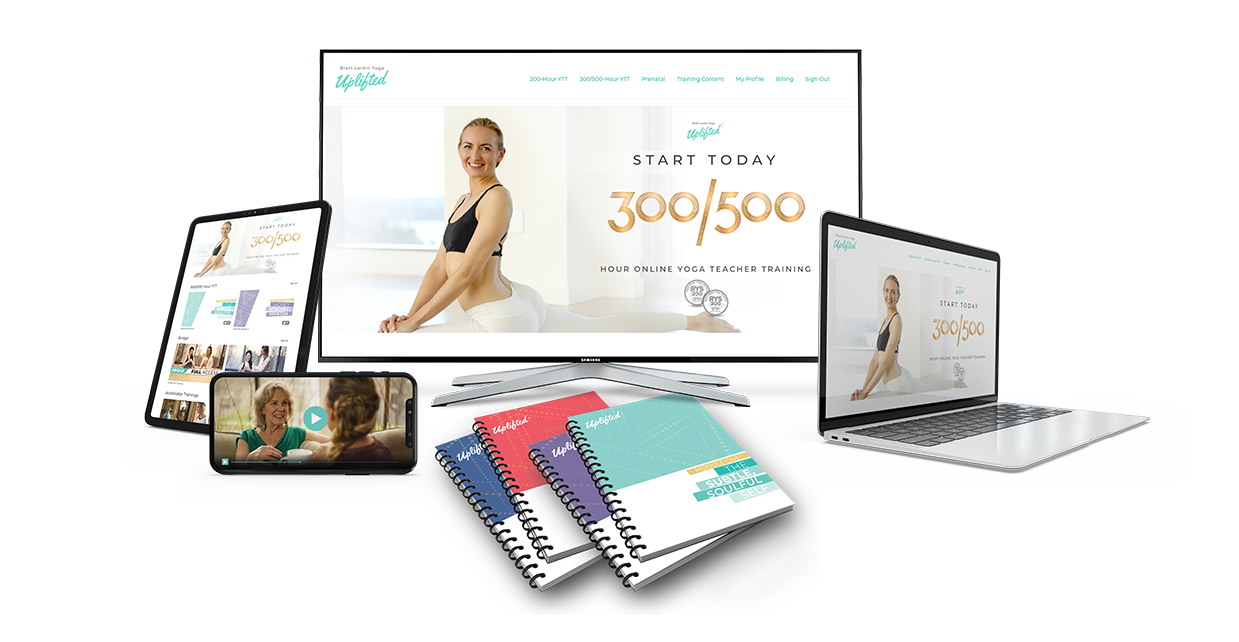
Let’s be honest, it’s no secret that the average yoga instructor doesn’t get paid much for teaching at a studio or the gym (the average rate is $31/per class). Factor in the pay, preparation time, and teaching the actual class; that equates to one stressed-out yoga teacher!
I’m here to inform you that there is a way to increase your income and diversify your client base as a corporate yoga teacher. What better way to spread the love of yoga for a population in great need of stress reduction while earning more money to support yourself and your dreams?
Let’s walk through the benefits of teaching corporate yoga for you and your new customer base so you can make some clear decisions on whether this teaching option is for you.
What Is Corporate Yoga and Why Start Teaching Yoga in the Workplace?
Corporate yoga is yoga classes that happen in the workplace. Teaching corporate yoga classes can create a steady source of income, a stable client base, and can help teachers avoid burnout. Does it sound too good to be true? Short answer: No! But it does require proper planning, patience, and diligence to be successful.
Helps Teachers Avoid Burnout
The average salary of a full-time yoga instructor is $30,000/year. This figure is based on teaching three yoga classes per day, approximately 20 classes per week with no days off. Consider the time it takes to plan the class and travel to multiple venues, not to mention maintaining your personal wellbeing and livelihood. The amount of pressure is not a sustainable way of living and can lead to high levels of burnout.
Corporate Yoga Is More Profitable
Corporate yoga is beneficial for a variety of reasons. Companies typically pay upwards of $125 per yoga class as a part of their corporate wellness programs. Securing a monthly contract with a company can provide you with a more reliable client base and the means to forecast your income so you can focus on the quality of your classes rather than the quantity to make ends meet.
Even though corporate yoga programs are a lucrative opportunity to pursue, yoga teachers tend to feel reluctant to contact companies. It can be challenging to know how to begin, who to contact, how to price the classes, and how to teach corporate yoga.
There are many ways to make a good living as a yoga instructor, and teaching corporates is just one. Read up!
Building Your Corporate Yoga Business

How To Find A Job Teaching Corporate Yoga
There are many ways to find corporate yoga jobs, but first, you have to be willing to hold space for a growth mindset. Finding clients may take time, but all your hard work will pay off. Consider these actionable tips.
- Leverage your personal network. Make a list of friends and family who have extensive networks, or work in a company setting. Ask them if they have a workplace wellness program in place and if they would be willing to put you in touch with the appropriate point person to discuss corporate yoga offerings.
- Get the word out. Let people know that you are offering yoga sessions to companies on community-based connection sites like Nextdoor or post your offerings on your social media pages. Ask people to connect you to people seeking a corporate yoga program. Provide an easy way for them to contact you.
- Do some research. Research companies in your area and make a list of organizations within your driving radius. Find the HR or corporate wellness contact and send a short email pitch that outlines your yoga offerings. Ask if they would consider your session as part of their wellness programs. Describe the benefits of yoga for mental health and stress reduction in a way that is relatable. Include a scheduling link for them to have a conversation with you.
- Search platforms. Yoga teaching jobs can be found on sites like Yoga Trade, Thumbtack, LinkedIn, Craigslist, and social media. Include your yoga resume when you send a response!
Get Your Paperwork Ready for Teaching Corporate Yoga
As an independent yoga professional in a corporate environment, proper paperwork must be in order to teach yoga. This is necessary for tax purposes and to ensure expectations are clear between you and your client.
Be prepared for companies to ask you about your teaching experience, references, corporate yoga rates, if mats and props are offered, the type of space needed to teach, how often you can teach, and how many employees you can accommodate.
Prepare the following items to ensure you are organized and have all the paperwork you need to teach corporate yoga.
- Yoga Teacher Resume. Your resume should detail your experience as a yoga teacher, associated professional or life experience, and how your teaching style incorporates stress management techniques
- Corporate Yoga Proposal. Draft a professional proposal with the type of yoga sessions and/or other wellness programs that you offer, benefits of a corporate yoga program in a work environment, pricing, and terms. Tailor your proposal to meet the needs of each client.
- Liability Insurance.Buy insurance before you teach yoga classes to protect yourself in the event of a lawsuit.
- Tax Forms. If your client has not asked for a tax form prior to teaching your first yoga class, be proactive and send them the appropriate form with the first invoice.
Pricing Your Private Corporate Classes
Before contacting people on your list, consider the level of customization and VALUE that you are offering as a private yoga instructor.
The general rule of thumb: factor in how much you would get paid at a studio or gym and multiply by two. Then, ask yourself, “Is this reasonable?” Whatever you do, do not undersell your services. You are your own boss. As a freelance yoga teacher, consider insurance fees, the costs of healthcare, and other operating costs needed to survive.
You have two ways to price your classes: charging a standard flat rate per class or charging per person.
If you are charging a flat rate consider using a price that is similar to your private yoga classes since you have factored in operating expenses, travel, and any additional costs.
If you decide to charge a per person rate, $20 is an average market price. Keep in mind that rates based on employee attendance will fluctuate, making pricing a little more complex to forecast for budgeting purposes.
Five questions to ask yourself as you price your yoga program for prospective companies.
- What are my operating costs?
- What is the going rate in my area?
- How far am I willing to travel?
- How many people will I be teaching?
- Will I need to bring yoga materials for employees?
Curious to learn more about pricing? Read: Private Yoga Lessons Cost: A Yoga Teacher’s Guide On How To Price Classes
Organize Bookings and Payment
There are a variety of yoga scheduling platforms available for teachers to seamlessly set up a class schedule, arrange for advance payments, and to provide clients with class updates. Some platforms keep a record of class attendance, manage memberships and signups, and offer scheduling services for online classes. Refer back to your goals and yoga business plan to decide whether these features are worth the expense.
If these platforms feel too complicated or expensive, consider using Calendly, a free scheduling system that syncs bookings across calendars. After a booking takes place, be sure to send an invoice to the client and any additional information about the session.
Drafting a cancellation policy into your proposal terms and conditions and/or booking platform is necessary to protect yourself and your clients. It sets clear expectations, takes potential conflicts into account, and shows respect for you and your client’s time. Over time something is bound to happen, a last-minute cancellation by you or a client, and you want to make sure your professional reputation is in good standing and you get paid if a client cancels at the last minute.
Speaking of collecting payments, many secure services like PayPal or Quickbooks are available to clients who want to use credit cards or offer electronic payments to streamline the process. Checks are great because they don’t have processing fees, but this option may not be the most convenient. Learn about some of the options available to you here.
Marketing for Your Niche Workplace
Many companies are looking to add yoga into their wellness programs. As you market your services, authenticity is key.
Spend some time identifying your niche by thinking about why you have chosen to focus your time, energy, well-being, and expertise to help reduce stress for others. Think about what makes your yoga teacher program different from others, and how you are highly trained to offer your niche services.
Consider why different types of workplaces might hire a yoga teacher. The benefits range from increased productivity levels, reducing job stress, less employee turnover, and a reduction of health care costs and doctor visits.
Research data to support your claims. The American Institute of Stress has some very good resources about how much job stress costs the workplace, the effects of high blood pressure as a result of physical stress or mental stress, and medically related productivity losses.
Be sure to find the right point of contact within the company. Friends or family employee referrals are always a good place to start. If you don’t have any contacts, find an HR contact in charge of benefits. Depending on the size of the company, CEOs are also a good point of contact.
Fall in love with my 300-Hour teacher training or …
Teaching Challenges for Corporate Yoga
An office environment is different from a yoga studio or gym setting. You may have shorter classes, people have a variety of job-related ailments (like carpal tunnel syndrome from typing on a computer all day long,) and many may be trying yoga for the first time.
Teaching a corporate class can come with many challenges but I have some tips on addressing these challenges like a pro!
- You have a wide range of yogic abilities. Create a welcoming atmosphere at the beginning of class by letting employees know the class is for everyone. Offer a lot of modifications, simple instruction, and demonstrate a restorative pose they can always come back to as needed.
- Class disruptions. Phones may ring, people may enter late / leave early, the lighting may not be right. The best advice I can offer you is to go with the flow. Start and end on time to respect the office environment, and hold a calming space for all who choose to participate.
- Yoga doesn’t feel attainable or doable. Take time to set up your space before class and stay after to answer any questions. Ask employees how they feel after class, and if they have any feedback for you. Provide them with tools (like breathing techniques) or inspiration to incorporate off the mat to make yoga feel more approachable.
Protip: Make sure to have a clear understanding of your client’s needs prior to planning your first class. This information will inform the class style, duration of class time, and how to prepare the room.
Most importantly, have fun! You are helping people de-stress in the midst of some very stressful situations!
Next Steps:
- Explore my Yoga Teacher Resource knowledge hub for more tips about how to grow your yoga business.
- Download my sequences for a jumpstart on your upcoming yoga classes!
- For more detailed tips, processes, and worksheets to supercharge your yoga business, download my yoga business launchpad course!

Sneak Peak into My 300-Hour YTT - FREE Videos, Info Session, Bonuses!

YOU MIGHT ALSO LIKE
- How To Build a Thriving Virtual Community with an Online Yoga Membership
- Somatic Yoga Workshop Ideas for Teachers
- Somatic Yoga For Yoga Teachers: Everything You Need to Know in 10 Steps
- How to Teach Somatic Yoga: A Practical Guide for Instructors
- How Much to Charge for Zoom Yoga Class: A Practical Pricing Guide
- Comprehensive Guide to Your Yoga Service Agreement
- How To Create Mindful Somatic Yoga Sequences Your Students Will Love
- 5 Affordable Yoga Teacher Insurance Plans (Updated 2024)
- 20 Awesome Ways To Make Money As A Yoga Instructor
- Yoga Cues 101: Everything You Need To Teach Yoga
- How Much Do Yoga Teachers Make? (And How To Earn More)
- How To Incorporate Somatic Coaching Into Your Yoga Practice
- How to Easily Modify 6 Common Yoga Poses [+VIDEO]
- Try This 30-Minute Yoga Nidra Script for Deep Sleep and Relaxation [+ Video]
- 8 Best Yoga Podcasts For Yogic Business And Living











